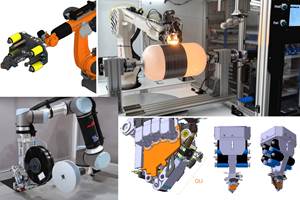FRP charge-air cooler stands up underhood
Injection molded glass/PA streamlines turbocharger intake manifold build.
In the quest to make internal combustion engines smaller and more economical, yet maintain high performance, engine designers often turn to turbocharging. The challenge is to engineer a way to cool air that must pass through the turbocharger. In the past, that has meant feeding this “charge air” up to the front end of the car for direct ambient cooling, then feeding it back to the engine intake manifold. Engine parts manufacturer MAHLE (Stuttgart, Germany), however, has developed a method of indirect charge air cooling, using a liquid coolant design, which saves space and prevents pressure drop, a risk factor associated with the other method.
The BMW Group’s (Munich, Germany) B58, the 3-liter, straight-six gasoline engine used in its 740i, 440i and 340i models since late 2015, features MAHLE’s innovative indirect charge air cooling design incorporated into the engine intake system. The charged air is cooled by a liquid coolant that is, in turn, cooled by outdoor air in a separate, compact low-temperature circuit that uses a small radiator mounted close to the engine. This concept opens up front-end space for other design purposes (e.g., pedestrian protection), and the bulky charge air hoses that would be used in direct charge air cooling are replaced by shorter, smaller-diameter liquid coolant lines. The compact system and short lines reduce pressure loss by around 50%. The higher density of the cooled charge air and lower pressure loss mean there is more air available to the engine for combustion. The result: improved engine responsiveness.
The concept, jointly developed by a team from MAHLE, BMW and DuPont Performance Materials (Wilmington, DE, US), required a heat exchanger/intake manifold housing made from a polymer that, when cured, would exhibit good stiffness and resistance to engine heat and chemicals, and be able to resist a phenomenon called hot-air aging. The latter describes brittleness that results when exposure to high temperatures drives out volatiles, in this case, plasticizers. The team selected DuPont’s thermoplastic polyamide 95G35, a 35% (by weight) glass fiber-reinforced grade of trademarked Zytel PLUS, which can withstand temperatures up to 230°C, with good weldability and flow characteristics. It incorporates DuPont’s proprietary SHIELD technology that reportedly combines an innovative polymer backbone with specific polymer modifications and additives that address aging.
The part consists of an upper and lower housing that, together, enclose an aluminum heat exchanger through which the liquid coolant flows. The housings are injection molded in one shot in a tool with a 1+1 cavity, then are joined via friction welding. The heat exchanger is inserted into the housing onto molded-in guides.
Martin Valecka, development project manager at MAHLE, says, “We needed a good balance of rigidity and impact strength, and the material allowed us to mold in thin-walled but highly effective supporting ribs that minimize deformation of the intake system even at high charge air pressures and temperatures, and ensure durability over the entire service life.” Tests show that the intake’s mechanical properties hold up even after 3,000 hours at 230°C — well above conventional polyamides.
Related Content
The next evolution in AFP
Automated fiber placement develops into more compact, flexible, modular and digitized systems with multi-material and process capabilities.
Read MorePlant tour: Airbus, Illescas, Spain
Airbus’ Illescas facility, featuring highly automated composites processes for the A350 lower wing cover and one-piece Section 19 fuselage barrels, works toward production ramp-ups and next-generation aircraft.
Read MoreIndustrializing additive manufacturing in the defense/aerospace sector
GA-ASI demonstrates a path forward for the use of additive technologies for composite tooling, flight-qualified parts.
Read MoreLow-cost, efficient CFRP anisogrid lattice structures
CIRA uses patented parallel winding, dry fiber, silicone tooling and resin infusion to cut labor for lightweight, heavily loaded space applications.
Read MoreRead Next
Ceramic matrix composites: Faster, cheaper, higher temperature
New players proliferate, increasing CMC materials and manufacturing capacity, novel processes and automation to meet demand for higher part volumes and performance.
Read MoreScaling up, optimizing the flax fiber composite camper
Greenlander’s Sherpa RV cab, which is largely constructed from flax fiber/bio-epoxy sandwich panels, nears commercial production readiness and next-generation scale-up.
Read MoreCutting 100 pounds, certification time for the X-59 nose cone
Swift Engineering used HyperX software to remove 100 pounds from 38-foot graphite/epoxy cored nose cone for X-59 supersonic aircraft.
Read More









